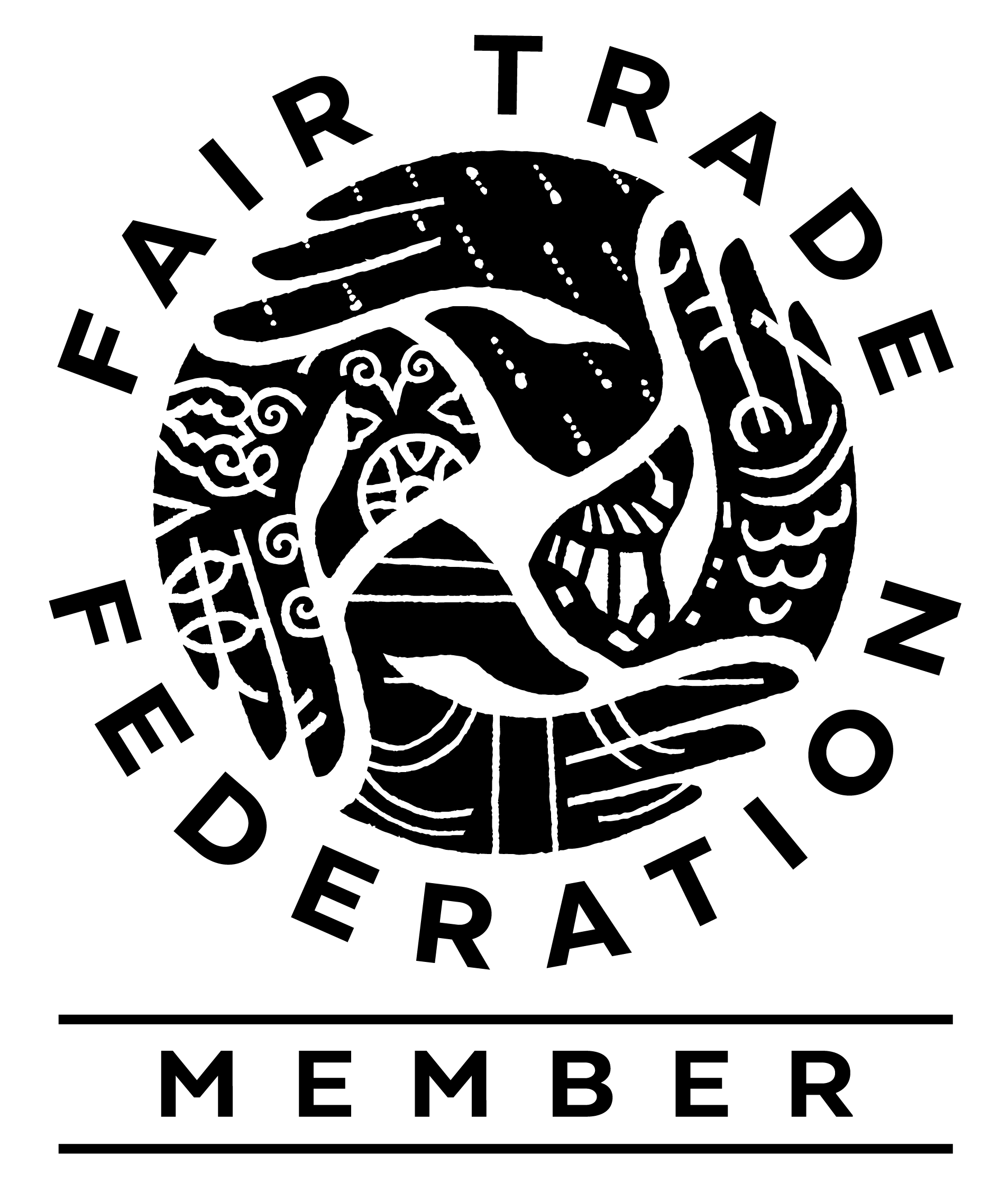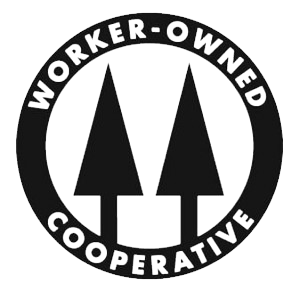From decadent cookies to hot chocolate to the perfect mocha, there are lots of reasons to love our rich and flavorful organic cocoa. But what’s the best thing about our cocoa? It’s the story–about farmer ownership, empowerment and an evolving supply chain.
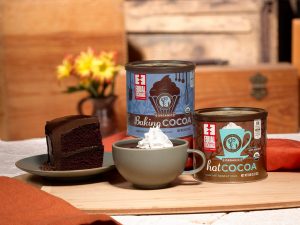 It starts in the Dominican Republic, where cacao trees grow abundantly in the tropical climate and cocoa is huge industry. Historically, this industry has been dominated by 4 dominant exporters, and farmers have had little involvement beyond growing, harvesting and selling to intermediaries.
It starts in the Dominican Republic, where cacao trees grow abundantly in the tropical climate and cocoa is huge industry. Historically, this industry has been dominated by 4 dominant exporters, and farmers have had little involvement beyond growing, harvesting and selling to intermediaries.
That’s where CONACADO (The National Confederation of Dominican Cacao Producers) has been blazing a trail since 1985. It began as a development project during a low in the global cocoa market, to study how cacao fermentation techniques could improve the quality of cacao production. Before then, 100% of Dominican cacao production was low-quality unfermented beans, which could be sold cheaply to the United States. But after successfully proving that higher quality, fermented cacao could increase income to small farmers, CONACADO expanded its work to educate farmers on these techniques and organize them into regional associations, or bloques. Then, the co-operative entered a commercialization phase of the project and began seeking out niche markets for their unique, high quality cacao.
Today, CONACADO is made up of over 8,500 farmer members, and 70% of their cacao is sold as high quality fermented beans in niche markets, with 40% of it sold on the Fair Trade market. Fair Trade premiums are distributed to the 8 bloques for use in community projects to improve education, infrastructure, health and development – and every project is determined, planned and executed through a democratic process.
In 2008, CONACADO made another bold move and purchased their own cocoa powder processing plant, taking a major part of production into their own hands. Now, rather than selling their beans to be processed by chocolate companies, the farmers are in control of producing their own semi-finished products.
“It is rare in the chocolate world for farmers to own any part of the chocolate processing, so the fact that CONACADO owns the plant is a game changer,” said Dary Goodrich, Equal Exchange Chocolate Products Manager. “In the conventional system, farmers are on their own selling to intermediaries who sell to huge multinational corporations, and a small handful of these corporations process the vast majority of the world’s cocoa beans into chocolate liquor, cocoa butter and cocoa powder. CONACADO is flying in the face of all this.”
So how is the cocoa powder actually made?
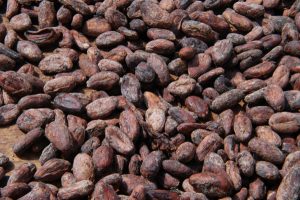 First, the fermented and dried cocoa beans arrive by truck at the plant and are carefully sorted, roasted and ground into chocolate liquor. This liquor is run through a hydraulic cocoa press that separates the solids from the fats. The fats are called cocoa butter, an essential ingredient in chocolate, though in this stage it’s mostly flavorless. During separation, the dry solids are pressed into a densely packed block which gets pulverized into cocoa powder. All the while, the staff performs quality checks and tests and ensures that each step of the process runs smoothly.
First, the fermented and dried cocoa beans arrive by truck at the plant and are carefully sorted, roasted and ground into chocolate liquor. This liquor is run through a hydraulic cocoa press that separates the solids from the fats. The fats are called cocoa butter, an essential ingredient in chocolate, though in this stage it’s mostly flavorless. During separation, the dry solids are pressed into a densely packed block which gets pulverized into cocoa powder. All the while, the staff performs quality checks and tests and ensures that each step of the process runs smoothly.
Dary recalls, “It’s a noisy process, but it’s always fun to move through the plant and watch the beans from CONACADO farmers get processed into an Equal Exchange product.” In 2014 alone, Equal Exchange purchased over 200,000 lbs. of cocoa directly from the plant for our baking cocoa, hot cocoa and spicy hot cocoa mixes.
The process, and the ownership of the plant, is not without its challenges – but with that comes a lot of learning and a lot of pride. It hasn’t been easy for CONACADO to fill the capacity of the plant and find markets for their cocoa powder and cocoa butter, but this significant ownership is a big step for the co-operative and a major development in the Dominican cocoa industry.
So the next time you add a spoonful of cocoa to your mug, we hope that you love it even more!
Shop our organic cocoas: baking cocoa, hot cocoa mix and spicy hot cocoa mix.
This is part three of a series on school fundraising. Read Part 2: Collecting Orders or Part 3: Distributing Orders
Running a school-wide fundraiser can be logistically challenging, but if your community is motivated and organized, you’ll see big results! And with an Equal Exchange school fundraiser, your community will support small-scale farmers and artisans at the same time.
 Last fall, Columbia Falls Middle School in Montana sold over $30,000 of fairly traded, organic products with an Equal Exchange catalog fundraiser to benefit their student council. Leslie DiMaio, a teacher and fundraising organizer at Columbia Falls (pictured, right, with top fundraising students), shared some of her strategies for success with us, which we’ll feature in this three part blog series.
Last fall, Columbia Falls Middle School in Montana sold over $30,000 of fairly traded, organic products with an Equal Exchange catalog fundraiser to benefit their student council. Leslie DiMaio, a teacher and fundraising organizer at Columbia Falls (pictured, right, with top fundraising students), shared some of her strategies for success with us, which we’ll feature in this three part blog series.
The key to a successful school fundraiser is good planning and preparation. Let’s go through it step-by-step:
1. Fill out your catalog agreement form and get the ball rolling! We suggest planning a two week fundraiser to make the best use of time and energy. You can even request catalogs months in advance and we’ll send them a few weeks before your start date.
Sign up here!
2. Assemble a good team of helpers (both kids and adults) who will help you promote the fundraiser, collect and distribute orders, and keep track of money coming in.
3. Figure out what you’re raising money for and how much you need. New sports uniforms? A band trip? Art supplies? Make sure everyone knows your goal and what the kids are looking forward to. Email or print and send a letter like this one to announce your school fundraiser.
4. Encourage homerooms to do weekly check-ins to solve problems and answer questions as they come up. Make sure teachers know about the educational tools available to them and encourage them to talk about Fair Trade using a short presentation.
5. Hold a kick-off assembly on a Friday to build excitement and get kids informed about how the fundraiser works. Have the student council, drama club, choir or other groups present information about your Fair Trade fundraiser in a creative way. (We think that skits, songs and visuals work well!) Announce your overall goal and the prizes for top-selling homerooms and students. Ask fun school-related trivia questions and hand out Equal Exchange samples as prizes.
 6. Make goal charts to post outside of each classroom so students can track their progress. (You can make goals relative to homeroom size and grade level.) Keep everyone motivated by filling in your progress bar together as you go along.
6. Make goal charts to post outside of each classroom so students can track their progress. (You can make goals relative to homeroom size and grade level.) Keep everyone motivated by filling in your progress bar together as you go along.
7. Make it fun for everyone! Distribute catalogs and samples of chocolate, coffee or tea in the teacher’s lounge. Invite the principal to host a pizza party for the top-selling class. Give small prizes to helpers and volunteers. And most importantly, remind everyone of the good they’ll be doing for communities around the world.
So your fundraiser is off to a great start. What’s next? We’ll share with you some best practices for collecting orders, staying organized and keeping everyone motivated.
“Breaking the crust” is a term used in coffee cupping to describe the action of using a spoon to release the true aroma and quality of coffee that has been steeping in a glass beneath a layer of frothy grounds. Reflecting back on my experience with an Equal Exchange/Presbyterian Hunger Program delegation trip to a coffee co-op in Nicaragua in early January, “breaking the crust” was exactly what the journey felt like for me. It was my first “real” travel away from my insulated life in the United States and I had the unique opportunity to reveal something that was authentic and powerful regarding the human connection between the work that I do every day at Equal Exchange and the farmers who are growing and harvesting the coffee we sell.
My sensory experiences throughout the trip were intense and meaningful at the small coffee farm we visited for three days in Dipilto, high in the mountains near the northwestern border of Nicaragua, close to Honduras. These experiences will stay with me and have opened my eyes wide to what is really inside a cup of coffee.
Scents linger – like the ever-present and comforting smell of burning wood in kitchen cooking fires, and the warm corn tortillas made by the loving hands of my homestay host mother, Doña Raina, at 4 a.m. I hear the giggles of shy children whispering about the pale strangers who had come to visit them and didn’t know many Spanish words. I hear the sound of heavy rain pelting the house as I sleep nestled in my sleeping bag – rain that doesn’t stop the work of the farmers picking and washing coffee outside all day.
I won’t easily forget the comforting flavor of savory gallo pinto, a traditional rice and beans dish in Nicaragua. the sugary squash dessert served in its hollowed out shell. The sour oranges plucked right from high in the mountains while we filled our baskets with bright red coffee cherries.
 I can still see the majestic and lush mountaintops under a blanket of early morning fog. The steep mountainside with tiny coffee plants reaching up tall toward the sunlight. The variety in colors of gorgeous ripening coffee cherries that resembled grapes as I tried to pick them off of the trees the right way, without any stems. I see the expression on Doña Raina’s face while she showed me her bandaged finger, cut while slicing a tomato to make us a fresh salsa. And I see the coffee plant leaves with yellowish-brown, rust-like spots, the roya disease threatening to destroy the livelihood of the co-op farmers across Central America and into South America.
I can still see the majestic and lush mountaintops under a blanket of early morning fog. The steep mountainside with tiny coffee plants reaching up tall toward the sunlight. The variety in colors of gorgeous ripening coffee cherries that resembled grapes as I tried to pick them off of the trees the right way, without any stems. I see the expression on Doña Raina’s face while she showed me her bandaged finger, cut while slicing a tomato to make us a fresh salsa. And I see the coffee plant leaves with yellowish-brown, rust-like spots, the roya disease threatening to destroy the livelihood of the co-op farmers across Central America and into South America.
The tactile feelings are still present on my fingertips, too. The texture of the slimy mucus inside coffee cherries. The smooth, warm hands of my travel companions linked in prayer before meals.
And emotions play back in my mind. The feeling of fighting off my quickness to label something as unpleasant just because it wasn’t easy. My challenge to see the dirt under my fingernails as earth and life instead of grime. Feelings of frustration with my lack of ability to communicate with limited Spanish but also pride that I was finally able to struggle through expressing my immense gratitude to my host family.
I am still experiencing the distinct feeling in my heart that tells me I have broken the crust.
Last year, we accomplished so much together. We’re so proud to have the support of coffee drinkers, chocolate lovers and authentic Fair Trade enthusiasts like you. You make it all possible.
Last year, our chocolate products used over one million pounds of organic, fairly traded cocoa beans and 500,000 pounds of organic, fairly traded sugar from small-scale farmers.
And Equal Exchange customers brewed, shared and enjoyed over 5.5 million pounds of coffee from small farmer co-ops.
That is a remarkable, incredible positive impact in the world of authentic Fair Trade. Thank you.
Here are some of the other highlights and projects from the last year!
Uganda Stoves Project
In the spring of 2014, together we raised $4,720 to help Ugandan women build energy-efficient stoves in their communities. These new stoves will make a remarkable difference in the lives of mothers and families. They require 50% less firewood, can cook more dishes at one time and more quickly, and provide a warm, smoke-free environment for families to spend time together in.
Read more about the inspirational Uganda Stoves Project.
Red Cherry Challenge
In June, we launched the Red Cherry Challenge, a yearlong initiative to support farmers in Guatemala and El Salvador. Several of our partner co-ops there have been hard hit by coffee rust, or roya, among other climate change-related problems. Participants in the Red Cherry Challenge see 10 cents for every pound of coffee they buy go toward funding resiliency and recovery efforts in these co-ops. Our customers raised $2,500 for the Red Cherry Fund so far. The Red Cherry Challenge continues into 2015, so it’s not too late to join and increase your positive impact!
Sign up for the Red Cherry Challenge and make your purchases count in 2015.
Small Producer Symbol (SPP)
In 2014, Equal Exchange adopted the Small Producer Symbol (or SPP, based on the Spanish acronym). This is the first Fair Trade farmer-owned certification, and is run and governed by small-scale farmers themselves. This is a bold and exciting next step in the authentic Fair Trade movement, and Equal Exchange is proud to bear the symbol that represents farmers in leadership roles.
Learn more about the groundbreaking Small Producer Symbol.
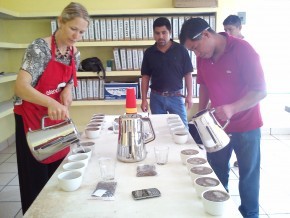 Cooperation in Quality
Cooperation in Quality
In 2014, we held our ninth annual Cooperation in Quality Seminar in Chiapas, Mexico, led by Quality Control Manager Beth Ann Caspersen. Ten cuppers from three different coffee co-ops in Mexico (Finca Triunfo Verde and CESMACH in Chiapas, and CEPCO in Oaxaca) came together for some hands-on learning about coffee quality, roasting and the tasting experience. The Cooperation in Quality Seminar brings diverse groups of cuppers together to cultivate a deeper understanding of the coffee they sell and the needs of buyers. This serves to professionally develop and empower the small farmer supply chain by passing on critical knowledge of the coffee industry and market. With every coffee tasted at the cupping table and every test batch of coffee roasted, the relationship between the coffee drinker and coffee producer grows stronger.
Read more about Beth Ann’s exciting Cooperation in Quality experience in Chiapas.
Cooperation in Productivity
In June, Green Coffee Buyer Carly Kadlec traveled to Marcala, Hoduras for our first Cooperation in Productivity event, a meeting of minds between farmers from both Honduras and El Salvador. Members of El Salvador-based co-op Las Colinas traveled to Honduras for intensive workshops and farmer-to-farmer learning. This was a successful and special opportunity for farmers to share their unique experiences and knowledge in order to strengthen the greater community of coffee farmers. The philosophy behind the event is summed up by Rodolfo Peñabla, the manager of COMSA: “If there is only one brain, it can only think so much. But, add another brain and another and another. What do you get? Farmers who generate ideas together. This is what we need.”
Read Carly’s reflection on the Cooperation in Productivity event.
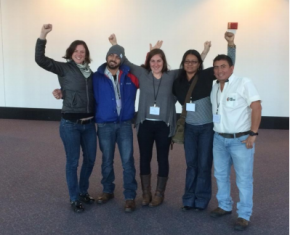 MANE Conference & Producer Visit
MANE Conference & Producer Visit
In November, three representatives of farmer co-ops came to visit Equal Exchange and participate as panelists in the MANE Coffee Conference in Providence, Rhode Island. Sonia Vásquez and Fredy Zelaya of COMSA (Honduras) and Marco Antonio Tzunun of Manos Campesinas (Guatemala) came to offer their perspectives on the ongoing crisis of coffee rust, both as agronomists and coffee producers. After participating in the conference, they visited the Equal Exchange café in Boston and the Equal Exchange office in West Bridgewater, MA to get to know some of us and talk about a few of the challenges facing farmers back home.
Grow Together Fund
In 2014, we launched the Grow Together Fund in partnership with food co-ops across the U.S., an effort to strengthen small farmer supply chains in the nuts and dried fruit category. With every purchase of Equal Exchange Cashews at participating stores, Equal Exchange and the store made a donation to the Grow Together Fund to support a tree planting project at APRAINORES Co-op in Honduras. By the end of the year, we raised $30,000 together! These funds will help plant new cashew trees, provide technical assistance, and create a Revolving Loan Fund which the co-op will manage to make small short term loans available to producer members. We’re excited to be laying to groundwork for healthy harvests, strong trade relationships and thriving communities.
Stay up-to-date with the developments of the Grow Together Fund.
 USAID Cooperative Quality and Productivity Program with Small-Scale Cocoa and Coffee Farmers
USAID Cooperative Quality and Productivity Program with Small-Scale Cocoa and Coffee Farmers
This five-year program began in 2010 with a grant from USAID, and this year we received a two-year extension in order to build upon the success and progress of the first four years. Our co-op partners involved in this project are Oro Verde, CONACADO, ACOPAGRO and Norandino. The work focuses on developing three key areas at the co-op level: quality, productivity and capitalization. Each area is critical to the empowerment and success of the co-ops, and there has been tremendous development in each. Some milestones include: building cocoa quality flavor labs and devising a cocoa tasting form, implementing a model farm program to improve productivity, and seeing the beginning of member equity programs so farmers can start to invest in their cooperatives. We are excited to be able to build on this foundation in the coming years. Stay tuned!
Valentine’s Day is a fun time to show love for your community, the environment and the farmers who grow our food. Here are some of our favorite ideas and activities for celebrating the things you love this February.
1. Try out a few chocolate-based recipes to share with friends! Our Mexican Hot Chocolate Cookies will warm your taste buds (and your heart). And who doesn’t love a cup of Fair Trade, organic hot cocoa? Get creative and try our Chai-Spiced Hot Cocoa for a unique twist on this seasonal classic.
2. Hold a short and sweet Valentine’s Day Fundraiser with our delicious organic chocolate. Wrap bars in pairs with decorative ribbon or twine, or sell individually wrapped Chocolate Minis. This is a great way to show love for your community!
3. Do something sweet for wildlife by making a pine cone bird feeder. The cold weather in many parts of the country may mean less time spent outdoors, but this is a fun and easy way to connect with the environment during the winter – especially with kids. Here’s how to do it.
4. Celebrate great partnerships with a chocolate and coffee tasting. Check out our guide to chocolate and coffee flavors and try out our recommended pairings. This is particularly fun with a group – host it at your congregation or community group.
5. Get crafty with the kids and make handmade valentine cards out of recycled paper for classmates, family members and friends. Cut out heart shapes and decorate with colored pencils, stickers and glitter. Attach individual chocolate hearts or chocolate minis for added sweetness!
Have other ideas? Tell us in the comments!
In late November, of 2014, I spent a day with PARC, Equal Exchange’s olive oil partner. As we drove from PARC’s headquarters in Ramallah to an olive growing community, Mohammad Hmidat, Quality Control Manager for PARC, pointed out a town called Bir Zeit, where centuries ago, Palestinian olive growers carved out wells in the rock to hold the year’s supply of freshly-pressed olive oil. We passed terraced hills covered with olive trees as we drove, and Mohammad explained that with care and judicious pruning, an olive tree can produce fruit for over 200 years. The oil co-ops here, supported by PARC, are doing what they can to ensure that the olive trees will bear fruit for centuries to come – in spite of some formidable obstacles.
PARC works with 40 olive oil co-ops, each of which is keeping tradition alive in their communities. On my visit to East Bani Zeid cooperative, I met with the co-op president, Rebhe Bakar, whose land and olive trees have been in his family for generations. We also visited the small mill that presses the co-op’s olives into oil. Jamal Hassan, who owns the mill with his father and brothers, walked us through a milling process in which nothing is wasted; every step of the olive oil production process contributes to the lives of people in the village. After the olives are pressed, the solids, a mix of olive fruit and pits, are compacted into balls and dried; these high-oil balls are later used as fuel to heat people’s homes. Later in the process, once the clear oil has been pumped out of its stainless steel tanks and taken to PARC’s bottling facility, the dregs at the bottom of each tank are allowed to settle one more time, and the oil that rises to the top, which contains too much sediment for eating, is used to make soap.
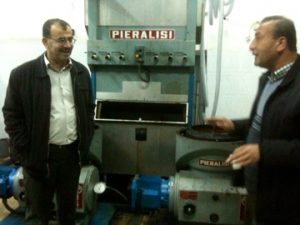 In some ways, maintaining traditions like these make this olive oil a bit different from most. Palestinian olives are planted on steep hillsides and must be harvested by hand. Olive trees in California and much of Europe, in contrast, are often planted in flat, dense rows that allow olives to be harvested by machine at lower cost. And unlike the large, mechanized farms with industrial facilities where olive pressing happens in huge batches, each of the 40 co-ops presses its own olives into oil, often in small, family-owned presses like the one owned by the Hassans. Their storage tanks, while made of stainless steel and kept scrupulously clean, are not housed in temperature-controlled buildings. As a result, the oil often begins to solidify in the tanks, much as olive oil does in a refrigerator. When filtered and bottled, tiny particles of olive fruit may remain suspended in the thickened oil. It’s a natural by-product of a process that is maintaining traditional pressing practices and keeps this unique aspect of Palestinian culture alive in a very real way.
In some ways, maintaining traditions like these make this olive oil a bit different from most. Palestinian olives are planted on steep hillsides and must be harvested by hand. Olive trees in California and much of Europe, in contrast, are often planted in flat, dense rows that allow olives to be harvested by machine at lower cost. And unlike the large, mechanized farms with industrial facilities where olive pressing happens in huge batches, each of the 40 co-ops presses its own olives into oil, often in small, family-owned presses like the one owned by the Hassans. Their storage tanks, while made of stainless steel and kept scrupulously clean, are not housed in temperature-controlled buildings. As a result, the oil often begins to solidify in the tanks, much as olive oil does in a refrigerator. When filtered and bottled, tiny particles of olive fruit may remain suspended in the thickened oil. It’s a natural by-product of a process that is maintaining traditional pressing practices and keeps this unique aspect of Palestinian culture alive in a very real way.
However, the current Israeli occupation imposes a constellation of hardships on Palestinian olive growers living in the West Bank and challenges the co-ops’ potential. The very formation of East Bani Zeid co-op arose as a result of the Israeli blockade of Gaza. With the previously important Gazan market closed to olive oil producers in the West Bank, farmers needed access to international markets to sell their oil. They turned to PARC for the training and support they needed to produce the consistently high-quality oil for export, as well as to facilitate the export process.
That process has become increasingly difficult over time. Since the Israeli government began to build the separation wall between Israel and Palestine about ten years ago, all people and products traveling between the two territories must pass through Israeli checkpoints for inspection. The oil on pallets that are removed from a Palestinian truck at a checkpoint and then loaded back onto an Israeli truck for their journey through Israel. Bottles are damaged and broken in the process, which costs PARC more than twice as much as shipping did before.
 However, PARC remains hopeful about the prospects for the olive oil sector in Palestine, in part because of the vibrancy of the co-ops themselves. Co-ops are one of the very few institutions that bring people together across political lines, as olive farmers with diverse political views unite to produce and market their olive oil. For me, it’s not really about the products at all; rather, the true impact lies in the vision of the PARC employees and farmers I met who want to build a robust, independent, peaceful Palestinian society that can sustain its hills of olive trees for hundreds more years to come.
However, PARC remains hopeful about the prospects for the olive oil sector in Palestine, in part because of the vibrancy of the co-ops themselves. Co-ops are one of the very few institutions that bring people together across political lines, as olive farmers with diverse political views unite to produce and market their olive oil. For me, it’s not really about the products at all; rather, the true impact lies in the vision of the PARC employees and farmers I met who want to build a robust, independent, peaceful Palestinian society that can sustain its hills of olive trees for hundreds more years to come.
Ready to get started right away?
1. Think ahead and start your school fundraiser early. The earlier you start, the more money you can raise! Start planning your fall fundraiser in the summer and lay the groundwork for a smooth back-to-school season. Start thinking about your spring fundraiser after the new year so everyone is ready to go when the spring energy hits.
2. Build a good team. An effective team consists of folks that bring different skills to the table. Look for the:
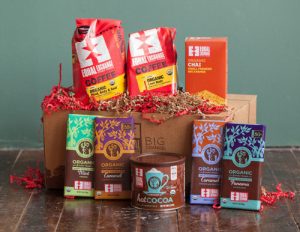 3. Set clear goals for the money you raise. What are you raising money for, and how much do you need? Clear goals will keep everyone motivated, focused and on track. And don’t forget to heavily promote your goal (new sports uniforms, a band trip, art supplies, etc.). It’s a huge incentive for the community to visualize what the students will get.
3. Set clear goals for the money you raise. What are you raising money for, and how much do you need? Clear goals will keep everyone motivated, focused and on track. And don’t forget to heavily promote your goal (new sports uniforms, a band trip, art supplies, etc.). It’s a huge incentive for the community to visualize what the students will get.
4. Pace yourself. Don’t try to do everything at once. Make up a clear and realistic timeline for the school fundraiser and a reasonable task list for volunteers. Then, stick to it, and don’t forget to make time to relax!
5. Keep everyone informed. Clear communication keeps things moving and helps everyone avoid surprises. Give parents advance notice so they are expecting the fundraiser, remind students periodically before their orders are due, and give teachers specific instructions for collecting and accounting for orders.
6. Get kids involved. Our Classroom Activities will bring Fair Trade to life for your students. Coach them on talking points and conversation starters to help them introduce their cause to potential customers. You can also provide incentives like goodie bags or a pizza party for top-selling students or classrooms. School fundraising can be a great social skill-builder and a huge school spirit booster!
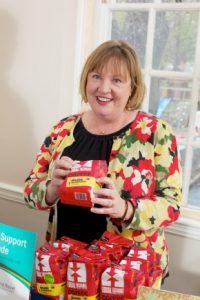 7. Relate the fundraiser to your values. Part of the reason you chose Equal Exchange is because of our mission. Share it with your community! There’s something for everyone to learn and appreciate about the values of Fair Trade and its impact on communities around the world. This is a valuable moment to demonstrate how you can make a difference near and far and work toward goals that benefit our global community.
7. Relate the fundraiser to your values. Part of the reason you chose Equal Exchange is because of our mission. Share it with your community! There’s something for everyone to learn and appreciate about the values of Fair Trade and its impact on communities around the world. This is a valuable moment to demonstrate how you can make a difference near and far and work toward goals that benefit our global community.
8. Expand your reach. You can go beyond your own school community to gather support for your fundraiser. Most people will be delighted to help your school and receive amazing products in return. Take catalogs to your workplace, congregation, book club, or community events.
9. Don’t forget to say “thank you.” Let your volunteers know you appreciate them with thank you cards from the kids or a luncheon at the end of the fundraiser. And thank your community supporters, too – thank you notes or community announcements can go a long way toward boosting spirit and encouraging folks to participate again next time.
10. Don’t be afraid to ask for help or advice. School fundraising can be easy and fun with the right approach and tools. If you have questions or need guidance, please don’t hesitate to call our Fundraising Expert Hotline: 508-427-5214. We’re here to assist you with the fundraising process so you can reach your goals. You can do this!
Or learn more about Fair Trade School Fundraising.
Want to continue to make your holiday sale unforgettable by offering fair trade gifts that make a real difference in farming communities around the world? Here are some bonus ideas that will take your sale up a notch and keep people engaged year after year.
 1. Get creative. Decorations and personal touches like ribbon, stickers and fun gift tags make any gift so much more fun. Don’t be afraid to ask for help from others – this is a great way to get more folks involved and let their creativity shine. For your sale table, use a colorful tablecloth and a string of lights to make it festive and eye-catching. Use display racks to help create space and make it easier for customers to browse.
1. Get creative. Decorations and personal touches like ribbon, stickers and fun gift tags make any gift so much more fun. Don’t be afraid to ask for help from others – this is a great way to get more folks involved and let their creativity shine. For your sale table, use a colorful tablecloth and a string of lights to make it festive and eye-catching. Use display racks to help create space and make it easier for customers to browse.
 2. It’s all about the samples. Everybody loves the chance to try something delicious, and they’ll want to buy once they have a taste! Some of our favorite tried-and-true treats:
2. It’s all about the samples. Everybody loves the chance to try something delicious, and they’ll want to buy once they have a taste! Some of our favorite tried-and-true treats:
3. Make the distinction. You know that fair trade is important for our global community, and now is a great time to tell your own community why it matters. The mission behind Equal Exchange’s ethically-sourced products will really set your holiday sale apart from gift options at corporate chain stores!
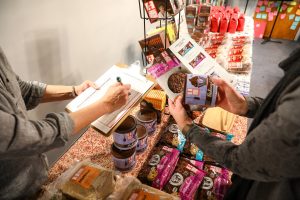
4. Not sure what products people want to buy? Take orders from our Fundraising Catalog and order exactly what they want while helping your group raise funds for your own causes. Your group gets a 40% profit margin!
Enjoy the spirit of the season, and thank you for bringing the best of small farmers to your community.
At Equal Exchange, we’re celebrating a Fair Trade Thanksgiving by sharing the many things that make us feel grateful. From family and friends to the food on our tables and the farmers who grow it, there’s a lot to be thankful for!
Thanksgiving is a great time to celebrate our passion for fairly traded food and the relationships that make our products possible. We couldn’t do it without our longstanding partnerships with farmer co-ops or the incredible support of people like you.
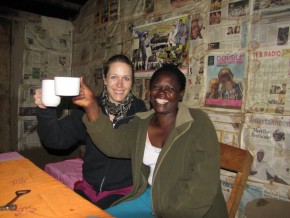 While sharing tables full of delicious things from near and far, we’re celebrating cooperation, collaboration and the hard work behind it all. We’re thankful for the company of friends and family, for our co-op, for our customers and for the farmers we work with year after year. Whether you’ve done the planting, the harvesting, the cooking or just the eating, you are a valuable part of our authentic Fair Trade community. You’ll always have a seat at our table!
While sharing tables full of delicious things from near and far, we’re celebrating cooperation, collaboration and the hard work behind it all. We’re thankful for the company of friends and family, for our co-op, for our customers and for the farmers we work with year after year. Whether you’ve done the planting, the harvesting, the cooking or just the eating, you are a valuable part of our authentic Fair Trade community. You’ll always have a seat at our table!
Happy Fair Trade Thanksgiving from everyone at Equal Exchange. Watch our video to hear some of the things we’re thankful for.
What are you thankful for? Tell us in the comments!
 Need some recipe ideas for your Fair Trade Thanksgiving? Try these seasonal classics with our fairly traded ingredients. Better yet, select ingredients are on sale for a limited time!
Need some recipe ideas for your Fair Trade Thanksgiving? Try these seasonal classics with our fairly traded ingredients. Better yet, select ingredients are on sale for a limited time!
October is Fair Trade Month, and there’s a lot to celebrate!
You already know that Fair Trade is important to farmers, communities and the planet, and that Equal Exchange’s partnerships help improve lives and land around the world. How will you showcase your support of better trade this month?
We have a few ideas to get you inspired and spreading the word about why Fair Trade matters.
 Brew an extra cup and share the Fair Trade experience. Try hosting a coffee hour or tea time featuring Equal Exchange. Brew up your favorite drink, whether it’s coffee from Ethiopia or tea from India, and share with friends at your home. You can talk about where it comes from, the importance of a healthy global community and how individuals can make it stronger. Bring your favorite blend of coffee to your office to share with coworkers, and let them know that supporting small farmers makes the world a better place.
Brew an extra cup and share the Fair Trade experience. Try hosting a coffee hour or tea time featuring Equal Exchange. Brew up your favorite drink, whether it’s coffee from Ethiopia or tea from India, and share with friends at your home. You can talk about where it comes from, the importance of a healthy global community and how individuals can make it stronger. Bring your favorite blend of coffee to your office to share with coworkers, and let them know that supporting small farmers makes the world a better place.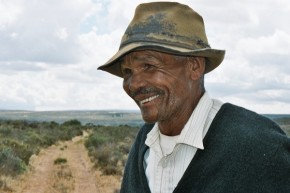 Celebrate our producer partners by reading some of their inspirational stories. Many farmer co-ops have overcome serious obstacles, challenges and disadvantages. Every worker has strived to build successful businesses, stronger communities and better futures. Get to know their histories and day-to-day stories by checking out our blog.
Celebrate our producer partners by reading some of their inspirational stories. Many farmer co-ops have overcome serious obstacles, challenges and disadvantages. Every worker has strived to build successful businesses, stronger communities and better futures. Get to know their histories and day-to-day stories by checking out our blog.
 Fair Trade Your Halloween! October also brings us this fun and spooky holiday, and with it comes lots and lots of chocolate. This year, make sure your treats are Fair Trade. Hand out fairly traded Chocolate Minis to your neighborhood ghosts and goblins, and talk about why supporting an ethical chocolate industry is important for kids around the world. Our Halloween Kits will help you get started with fun info cards and delicious bite-sized Minis. You can also spread the word with a digital Trick-or-Treat for a chance to win weekly prizes!
Fair Trade Your Halloween! October also brings us this fun and spooky holiday, and with it comes lots and lots of chocolate. This year, make sure your treats are Fair Trade. Hand out fairly traded Chocolate Minis to your neighborhood ghosts and goblins, and talk about why supporting an ethical chocolate industry is important for kids around the world. Our Halloween Kits will help you get started with fun info cards and delicious bite-sized Minis. You can also spread the word with a digital Trick-or-Treat for a chance to win weekly prizes!How will you celebrate Fair Trade month? Share your ideas in the comments!
Want more ideas and creative ways to bring Fair Trade to your community? Sign up for our newsletter and be the first to hear about new products, recipes, farmer stories and sales.


